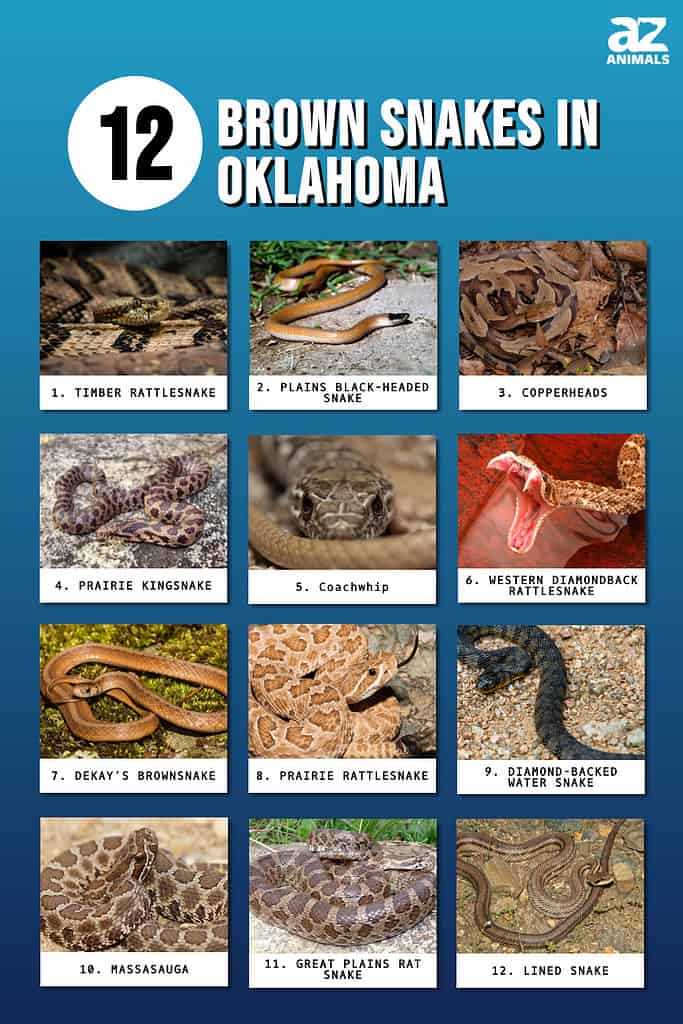
Located in the southcentral region of the US, Oklahoma has a vast array of habitats — including mountains, prairies, forests, and rivers. It is teeming with wildlife but especially snakes. There are 46 species in the state, including seven that are venomous. While some snakes feature bright colors, others are simply an understated brown. So, let’s learn about the brown snakes in Oklahoma, including where they live, and which are dangerous!
1. Timber Rattlesnake (Crotalus horridus)
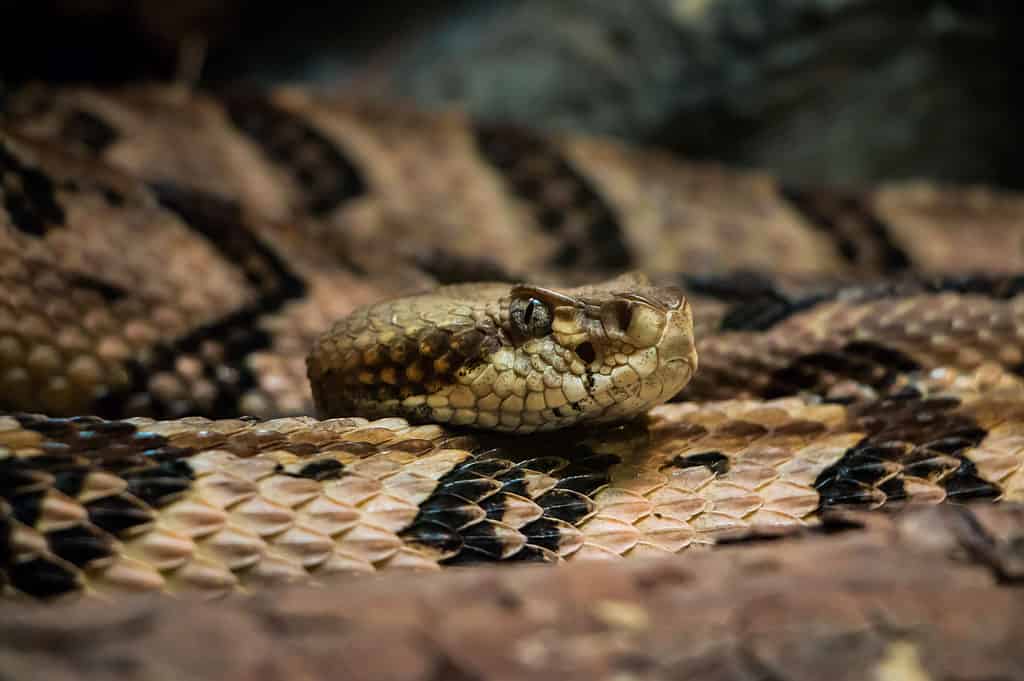
Timber
rattlesnakes
are typically brown with dark brown or black crossband markings.
©Dennis Riabchenko/Shutterstock.com
We’ll kick off the list with the timber rattlesnake, which is a large, powerful pit viper that ranges between 36 and 60 inches long. Timber rattlesnakes are typically brown with dark brown or black crossband markings. However, some “black phase” snakes have dark bodies and even darker crossbands, making them appear to be black. They live in the central and southern regions of the state in forests and areas with rocky outcrops. Timber rattlesnakes are one of the most venomous snakes in North America as they have a high venom yield and possess long fangs with which to inject it with.
2. Plains Black-Headed Snake (Tantilla nigriceps)
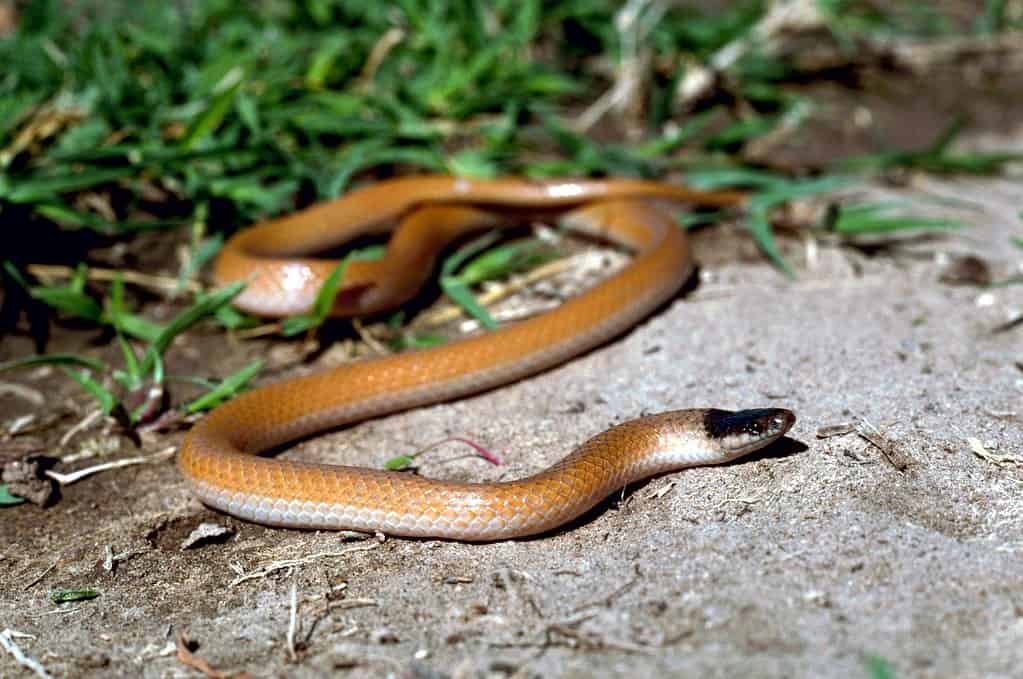
The plains black-headed snake is only mildly venomous to their prey, not to humans.
©Gary M. Stolz, U.S. Fish and Wildlife Service, Public domain, via Wikimedia Commons – License
One of the smallest snakes in the state is the plains black-headed snake, which is only 7 to 12 inches long. Plains black-headed snakes are brown with distinctive black heads. They also have a lighter-colored belly which has a pink line running down the center. Plains black-headed snakes live in grasslands, prairies, and rocky hillsides with moist soil across the western half of the state. They are mildly venomous to their prey and possess a set of small, rear fangs. However, they are not dangerous to humans. Due to their small size, they prey only on small insects and centipedes.
3. Copperheads (Agkistrodon laticinctus/Agkistrodon contortrix)
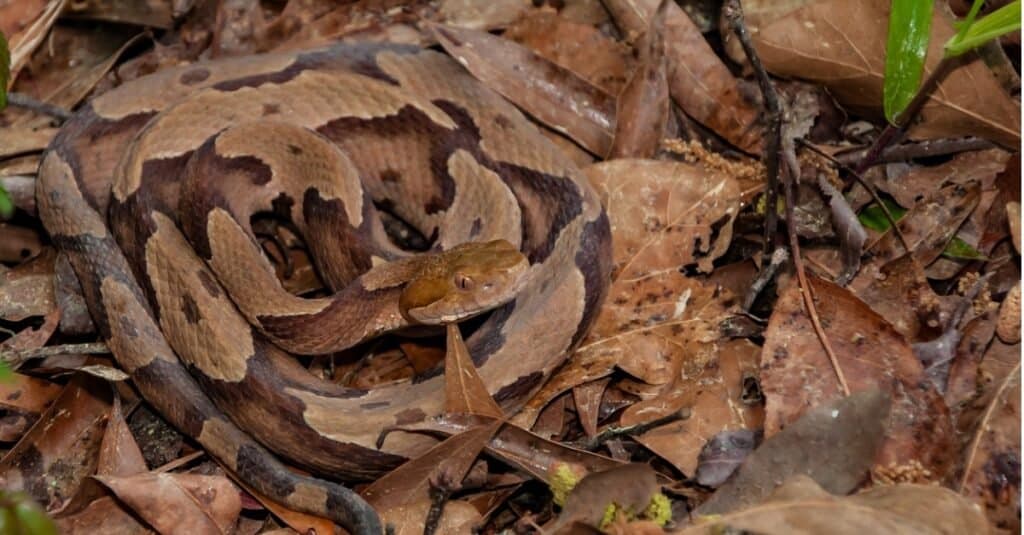
Copperheads inhabit the eastern region of the state and live in woodlands and areas around ponds and streams.
©iStock.com/JasonOndreicka
Oklahoma is home to two species of copperhead snakes — the eastern copperhead and the broad-banded copperhead. Both are around 20 to 36 inches long and have pinkish-brown bodies with darker brown crossbands. However, the broad-banded copperhead has wider markings than those of the eastern copperhead. Copperheads inhabit the eastern region of the state and live in woodlands and areas around ponds and streams. Although they are venomous, their venom is fairly weak compared to some of the other toxic snakes in the state. Any bite from a venomous snake should be taken seriously and medical help sought but bites from copperheads are not usually fatal for healthy adults.
4. Prairie Kingsnake (Lampropeltis calligaster)

The prairie kingsnake is 30 to 40 inches long and has a light brown body with darker reddish-brown blotches.
©Matt Jeppson/Shutterstock.com
Another brown snake in Oklahoma is the prairie kingsnake which is 30 to 40 inches long and has a light brown body with darker reddish-brown blotches. There is a central line of blotches down the back and then two rows of small blotches running along each side. Prairie kingsnakes are not dangerous to humans and prey on a range of lizards, frogs, rodents, and other snakes. They live in woodlands, prairies, and pastures and spend much of the daytime in the undergrowth or underneath rocks. They occur across the entire state with the exception of the Panhandle region.
5. Coachwhip (Masticophis flagellum)

They have the appearance of a braided coachwhip — hence their name.
©Alexander Wong/Shutterstock.com
The coachwhip has a unique appearance, which begins with a black head and neck and fades to light tan at its tail. This, combined with their smooth scales, gives them the appearance of a braided coachwhip — hence their name. Coachwhips are some of the longest snakes in North America and can reach around 7 feet. Coachwhips live across the entire state in grasslands and on dry, rocky hillsides. They are not venomous but are quick, active snakes and prey on a variety of snakes, rodents, and lizards. When they are cornered, they will strike at the threat and vibrate their tail. Although legend says that they will chase down their foe and whip them with their tail, this is not true!
6. Western Diamondback Rattlesnake (Crotalus atrox)
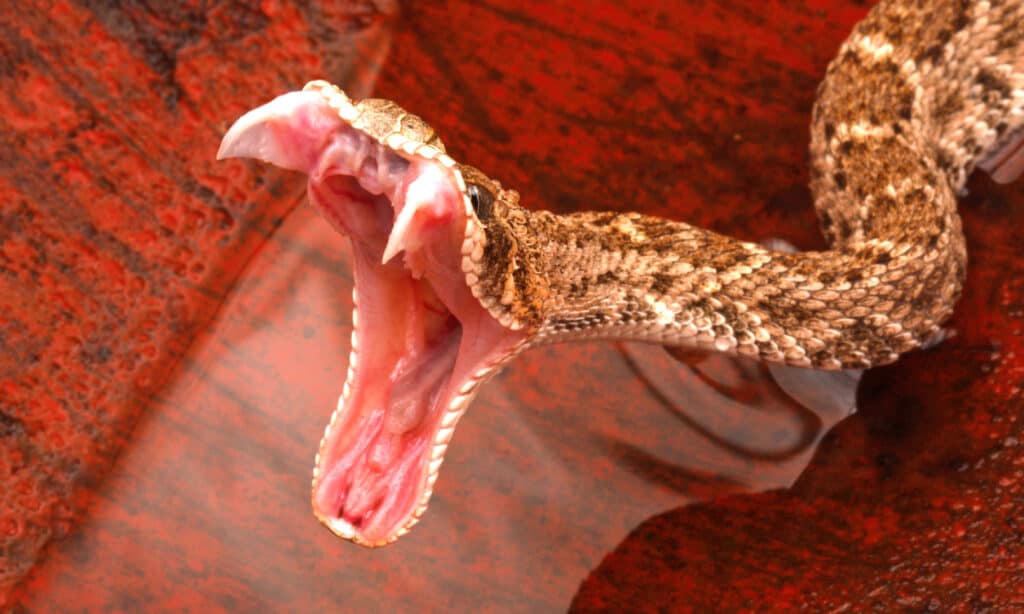
Diamondback rattlesnakes are highly aggressive and will often strike when they are threatened.
©iStock.com/johnaudrey
The next venomous snake on the list is the western diamondback rattlesnake, which lives mainly in the eastern and southwestern regions of Oklahoma. They tend to prefer dry areas across mountains, prairies, and canyons. Western diamondback rattlesnakes typically reach 4 feet long, although longer specimens are not unusual. They are a grey-brown color and have a series of dark brown diamond-shaped markings. Diamondback rattlesnakes are highly aggressive and often strike when they are threatened. They have a high venom yield and contain primarily hemotoxic venom which destroys red blood cells.
7. Dekay’s Brownsnake (Storeria dekayi)
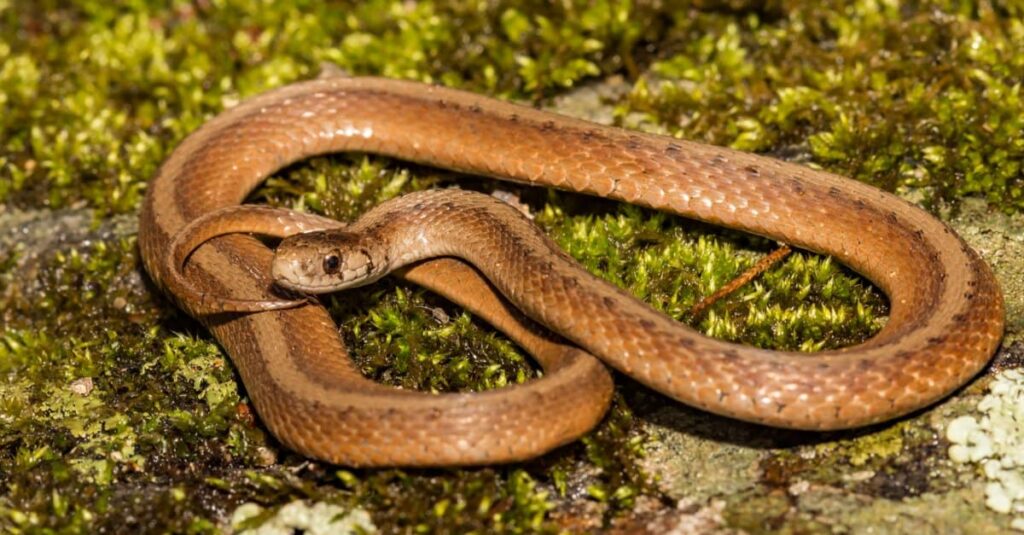
They occur across the majority of the state with the exception of the Panhandle and the southeastern corner.
©Jay Ondreicka/Shutterstock.com
Another small brown snake in Oklahoma is Dekay’s brownsnake, which is only 9 to 13 inches long. They have slender bodies, which are a light brown ground color. They also have a stripe down their back with dark brown or black spots on either side of it. Dekay’s brownsnakes are not dangerous to humans and prey only on slugs, snails, and earthworms. They occur across the majority of the state with the exception of the Panhandle and the southeastern corner. They prefer to live in woodlands but can sometimes live near marshlands too.
8. Prairie Rattlesnake (Crotalus viridis)
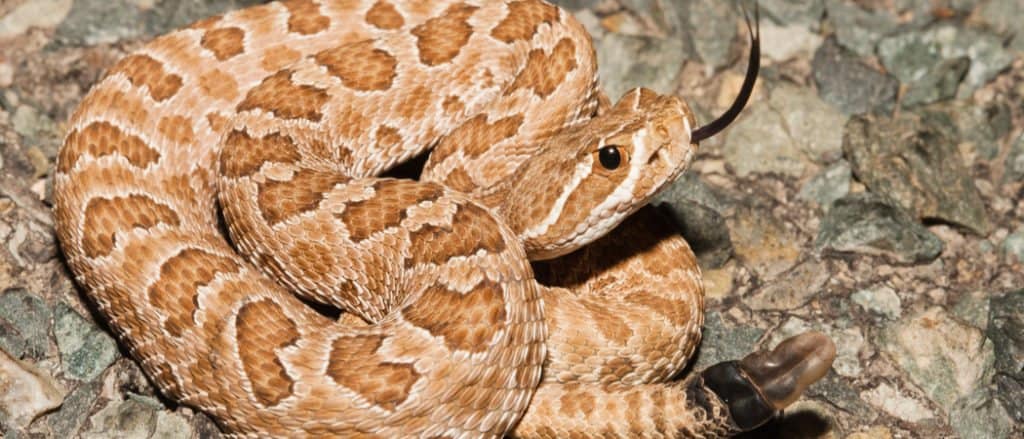
They are typically 35 to 45 inches long and have light brown bodies which are overlaid with a series of irregular-shaped dark brown blotches.
©Nathan A Shepard/Shutterstock.com
One of the most dangerous snakes in Oklahoma is the highly defensive and highly venomous prairie rattlesnake. Prairie rattlesnakes possess cytotoxic and hemotoxic venom which can damage tissue and blood cells. They are typically 35 to 45 inches long and have light brown bodies, which are overlaid with a series of irregular-shaped dark brown blotches. They only occur in the Panhandle and the counties along the western edge of the state. Their habitat includes grasslands and rocky outcrops where there are plenty of small mammals for them to prey on.
9. Diamond-Backed Water Snake (Nerodia rhombifer)
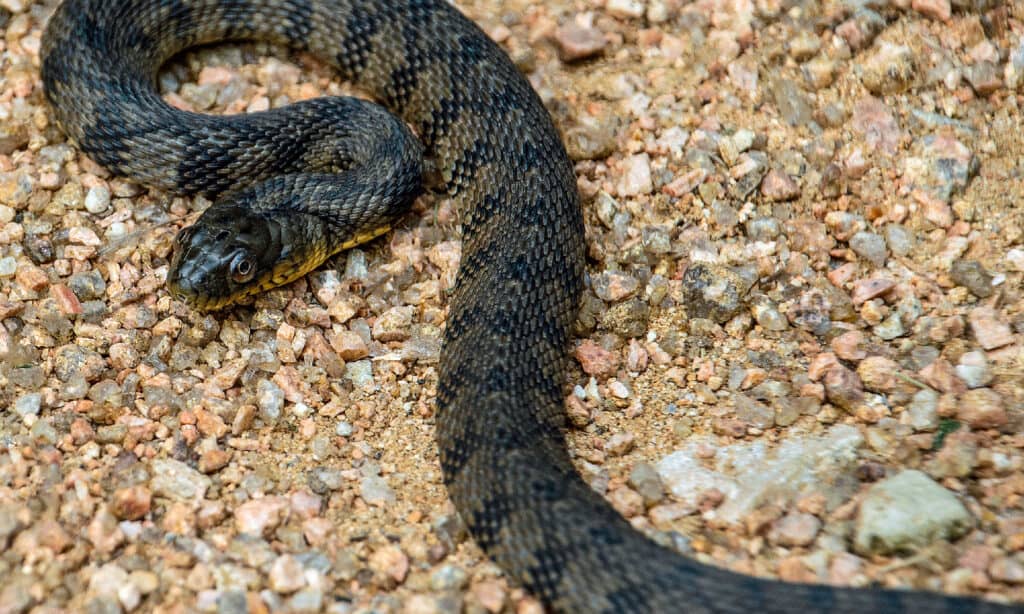
Diamond-backed water snakes are 30 to 48 inches long and have greenish-brown bodies.
©iStock.com/williamhc
There are several water snakes in Oklahoma, one of which is the diamond-backed water snake. These snakes live in permanent bodies of water — particularly slow-moving ones such as ponds and streams — across most of the state, barring the Panhandle region. Diamond-backed water snakes are 30 to 48 inches long and have greenish-brown bodies with keeled dorsal scales and a dark brown diamond-shaped pattern on their back. They prey mainly on fish and frogs are are not venomous or dangerous to humans. They sometimes hang from branches over the water but are quick to flee when humans are around.
10. Massasauga (Sistrurus catenatus)

Massasaugas live in the western half of the state on rocky hillsides.
©Matt Jeppson/Shutterstock.com
The final venomous brown snake on the list is the massasauga, which is another rattlesnake species. Massasaugas are 24 to 30 inches long and have a tan-colored body with brown or black blotches along the length of their back. They also have three rows of small blotches on each side. Massasaugas live in the western half of the state but are not present in the Panhandle. They mainly live in grasslands and swamps but can inhabit rocky hillsides. There are three subspecies, and the western massasauga is the one that occurs in Oklahoma. Massasaugas possess cytotoxic venom, which can destroy tissue, although they are fairly shy snakes and are not naturally aggressive.
11. Great Plains Rat Snake (Pantherophis emoryi)
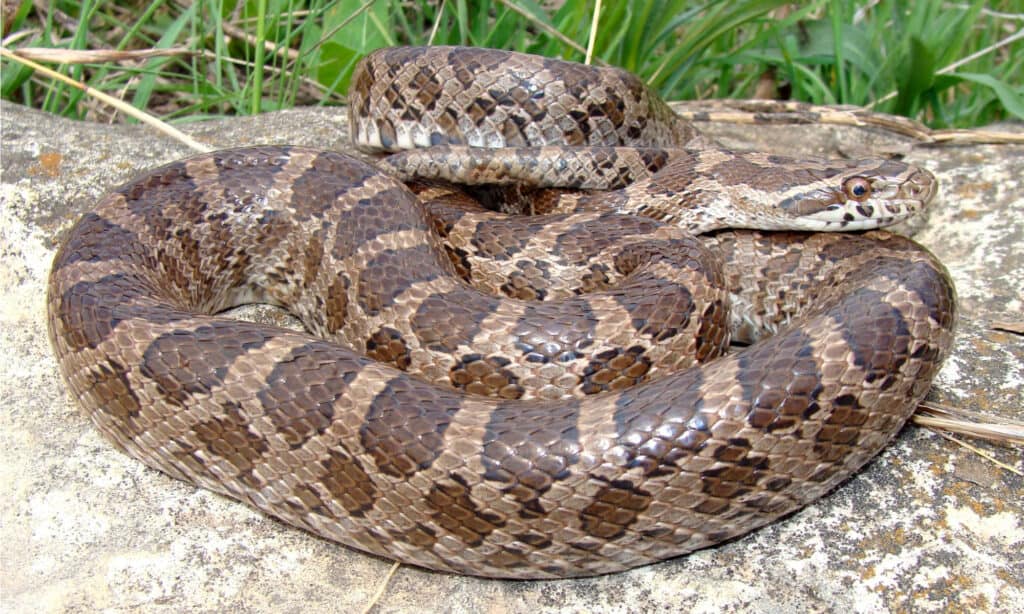
Great Plains rat snakes are not venomous and are generally considered to be beneficial due to the large quantities of rodents they consume.
©Matt Jeppson/Shutterstock.com
Next up is the great plains rat snake which occurs everywhere in Oklahoma except in the southeastern corner. They live in a wide range of habitats but can commonly live in woodlands, farms, and on rocky hillsides. Great Plains rat snakes are typically 24 to 36 inches long, but longer animals can be up to 5 feet. They have tan bodies with dark brown to black blotches on their sides and stripes underneath their tail. Great Plains rat snakes are not venomous and are generally beneficial snakes to have around due to the large quantities of rodents they consume.
12. Lined Snake (Tropidoclonion lineatum)
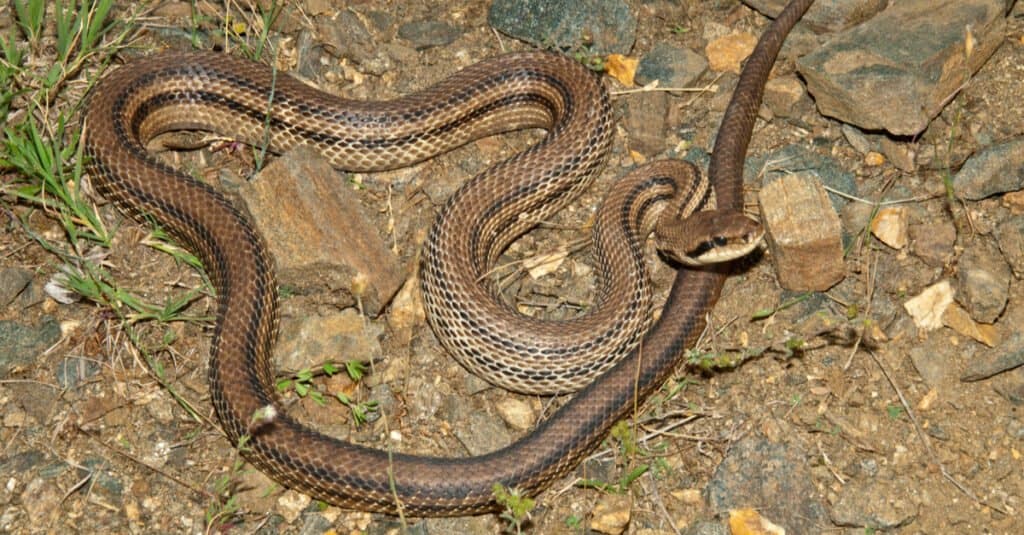
Lined snakes live in prairies and woodlands but spend the majority of their time either buried in the soil or hidden away underneath logs.
©imageBROKER.com/Shutterstock.com
Finally, we have the lined snake which occurs in the central region of the state. Lined snakes are only 7 to 16 inches long and have brown bodies with a yellowish-brown stripe running down the center of their back. They also have a stripe on each side and black spots on their belly. Lined snakes live in prairies and woodlands but spend the majority of their time either buried in the soil or hidden away underneath logs, rocks, or leaves. They are completely harmless to humans and prey mainly on earthworms.
Summary Of 12 Brown Snakes In Oklahoma
| Rank | Brown Snake |
|---|---|
| 1 | Timber Rattlesnake (Crotalus horridus) |
| 2 | Plains Black-Headed Snake (Tantilla nigriceps) |
| 3 | Copperheads (Agkistrodon laticinctus/Agkistrodon contortrix) |
| 4 | Prairie Kingsnake (Lampropeltis calligaster) |
| 5 | Coachwhip (Masticophis flagellum) |
| 6 | Western Diamondback Rattlesnake (Crotalus atrox) |
| 7 | Dekay’s Brownsnake (Storeria dekayi) |
| 8 | Prairie Rattlesnake (Crotalus viridis) |
| 9 | Diamond-Backed Water Snake (Nerodia rhombifer) |
| 10 | Massasauga (Sistrurus catenatus) |
| 11 | Great Plains Rat Snake (Pantherophis emoryi) |
| 12 | Lined Snake (Tropidoclonion lineatum) |
The photo featured at the top of this post is © Paul Reeves Photography/Shutterstock.com
Discover the "Monster" Snake 5X Bigger than an Anaconda
Every day A-Z Animals sends out some of the most incredible facts in the world from our free newsletter. Want to discover the 10 most beautiful snakes in the world, a "snake island" where you're never more than 3 feet from danger, or a "monster" snake 5X larger than an anaconda? Then sign up right now and you'll start receiving our daily newsletter absolutely free.
Thank you for reading! Have some feedback for us? Contact the AZ Animals editorial team.






